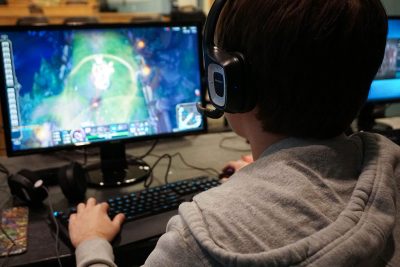In our recurring 10 Questions series, the Neag School catches up with students, alumni, faculty, and others throughout the year to offer a glimpse into their Neag School experience and their current career, research, or community activities.
In their recently published edited volume, Exploding the Castle: Rethinking How Video Games and Game Mechanics Can Shape the Future of Education (Information Age, 2017), Neag School faculty Michael Young and Stephen Slota — both longtime video game devotees — explore the value of games, the role of games in the future of K-12 and higher education, and more.
Here, Young, associate professor of cognition, instruction, and learning technology, and Slota, assistant professor-in-residence of educational technology discuss the book and share their insights on the intersection between games, technology, and learning.
What about gaming initially captured your interest?
Stephen Slota: I’ve been a gamer since I was very young. Much of my experience revolves around video and board games (the Super Nintendo Entertainment System being my first console). The combination of creativity and strategy is likely what spurred my interest — I loved drawing, and I loved puzzles, so games were a natural fit. I even mailed Nintendo headquarters a few game ideas!
Michael Young: Me, too. Like Steve, I have always been fascinated by jigsaw puzzles, board games, and actual sports, like tennis. But when the games are on the computer and can be played with thousands of others around the world simultaneously … now that gets fun. “World of Warcraft” was such a game for me.
“A quality game experience is one that enables you to accomplish some goal that is meaningful to you.”
—Michael Young, associate professor
What do you believe makes a quality video game or gaming experience?
SS: Different games can be appealing to different players for very different reasons, or even to the same player placed under different conditions —whether emotional, psychological, or physical. This makes it difficult to say concretely what makes for a ‘good’ or ‘bad’ game or gaming experience.
Personally, I find myself most engaged with games that have a cohesive narrative, challenging puzzles, interesting character interactions and development, player agency, and internal consistency (i.e., objects, characters, and interactions work as we would expect them to in the given game world). “The Legend of Zelda: Breath of the Wild” is my go-to example for A+ design.
MY: Steve is right … gameplay is “situated,” meaning that it unfolds on the fly, in a different context every time. So it is not possible to make broad generalizations about how gameplay might affect any particular student or groups of learners. For me, games like “Two Dots” meet a need for a distraction to cleanse my concentration during the day, while “Pokemon Go” gets me out walking around, something I also need to do more. A quality game experience is one that enables you to accomplish some goal that is meaningful to you.

What are the greatest myths or misconceptions about video games that you would like to see dispelled?
SS: There are two myths that really need to be dispelled.
First, that violent video games cause violent behavior. There are correlations between aggression and violent video gameplay, but there are similar correlations between aggression and reading violent passages in books, including works like the Iliad and the Bible. Like those, video game aggression appears to dissipate minutes after play, often below aggression levels measured pre-play — meaning “Mortal Kombat” and “Grand Theft Auto” are more likely to help a player burn off steam than induce horrific, real-world outcomes.
Second, that games are a silver bullet for fixing all that’s broken in education. Try as we might, no individual game will ever be able to meet the individual needs of every individual student. Our goal should simply be to ensure or afford players as many opportunities to tackle target learning objectives as possible.
MY: My favorite game myth is that if something is playful, it can’t be serious. Children play cops and robbers and war games like capture the flag. Certainly we can all agree war is deadly serious. Children also play house, and certainly that part of life is quite important to us as well. … Any teacher or parent who dismisses games and playful learning as not serious about the school curriculum has to reconsider that thought.
“Games are interactive fiction — and narrative will never be unimportant to teaching, learning, and human cognition.”
—Stephen Slota, assistant professor-in-residence
How do you see gaming as being relevant, beneficial, or important to learning, teaching, and/or the field of education?
SS and MY: Though the specific technologies used to create and implement educational games will continue to evolve, cycle into and out of popularity or out of use altogether, the broader concept will almost certainly persist as instructional strategies (hopefully informed by contemporaneously evolving learning theory). In the short term, [games] will likely become popular as part of massive online open courses (MOOCs), mobile/personalized “just in time” learning modules or applications, and competency-based evaluation methods, all of which we touch on in Exploding the Castle. Games are interactive fiction — and narrative will never be unimportant to teaching, learning, and human cognition.
Do different video games offer different benefits or help strengthen certain skills?
SS and MY: Each game — video or otherwise — offers a range of something we call affordances. In brief, affordances are the opportunities for action we perceive (see, touch, feel, etc.) around us and, under the right circumstances, choose to act upon.
One possible affordance of a game like “Assassin’s Creed” might be to use it as the basis for a history project (by way of comparing the game’s content to actual historical records). A puzzle game like “Tetris” affords players an opportunity to demonstrate and develop spatial recognition and manipulation skills. Games like “World of Warcraft” afford a range of social interaction and problem-solving opportunities (both individual and group), allowing players to develop very different skills than they might have developed through a game like “Super Mario Bros.”
Dr. Slota, you previously served as a high school teacher. Did you incorporate gaming into your classroom in any way?
SS: While I was teaching high school, I incorporated gaming — or game-like activities, at least — as often as I could. This was partly because it made lesson planning more engaging for me, but, more importantly, because some of my early gamified instructional experiments did wonders for engaging my students.
The effects were pronounced enough that I actually made the decision to return to graduate school after a particularly successful game-based unit that involved my lowest-tracked 10th- and 11th-grade biology students roleplaying as epidemiologists to investigate a fictional disease outbreak. Overall interest and achievement improved so dramatically in such a short period of time that I knew I’d tapped into something special, even if I didn’t yet understand it. Incidentally, a (2008) UConn Advance profile on Mike (Young) and Roger Travis was what started me down the educational psychology, technology, and game design path.
MY: I serve on the Ellington (Conn.) Board of Education. There, I get to see how games and playful learning are an increasing part of K-12 schools, starting from every kindergarten student’s day, and with the increasing use of technology for learning, building up in all classrooms with virtual environments to learn and role playing games that organize entire high school courses. Add to this the use of playful learning in times between classes (as in Makerspaces) and after school (as in robotics clubs and esports) and you have a pretty substantial role for games in schools.
Should more schoolteachers be finding ways to incorporate gaming it into their curricula?
SS and MY: While students at all levels can and do benefit from games and playful learning in their classes, not all teachers should necessarily have to incorporate games into their curricula. Teaching is partly a skill that must make contact with one’s personal goals and interests. To be genuine in the classroom, a teacher cannot be just doing what they are told. Teaching has to come from them. So to the extent that more teachers could be helped to find ways to incorporate games whose play can align with their desired student learning outcomes, then, yes. The more we do research and understand how games and playful learning can work, then we can design professional learning experiences to invite more teachers to try it. But I don’t think we’d ever say that games are the magic bullet that all teachers should be using.

What audiences are you intending to reach with your book, Exploding the Castle, and what do you ideally hope those audiences take away from it?
SS and MY: We focused principally on students, teachers, parents, administrators, researchers, game designers, and self-described gamers.
It’s our hope that the volume will inspire more advanced and theoretically sound designs going forward, particularly among aspiring and practicing educators.
What would you tell people considering a career related in some way to gaming?
SS: My journey to the realm of educational game design and research is pretty nontraditional. I started out as pre-med with a focus on genetic engineering, made my way into K-12 education, and later found a serendipitous opportunity to blend my skills in art, science, education, and game design through the Neag School’s Cognition, Instruction, and Learning Technology program. That makes giving advice a bit challenging, but the following capture my ‘big ticket’ thoughts:
- Connect with researchers and game designers to explore the creation of your own games or game-infused activities. One useful resource includes the Higher Education Video Game Alliance.
- Explore different examples of gamification and game-based learning. Consider which learning theories (if any) were used to develop those games and whether or not the game maintains a consistent 1:1 ratio of game and learning objectives. (For a brief introduction, see Slota, 2017.)
- Review James Paul Gee’s What Video Games Have to Teach Us About Learning and Literacy (St. Martin’s Griffin, 2007), considered a seminal work within the field of game-based learning.
- Play games. Play many different types of games. Get a sense of which mechanics best meet your instructional and other needs.
What are you most excited about when it comes to the future of gamification?
SS: Game-based instruction is going to shape and be used to teach in the ever-expanding world of online and mobile education. Many popular technologies (e.g., FitBit, Apple Watch, digital insulin monitors/injectors) already utilize various games or game-like apps to promote user engagement and inform individual well-being, and some artistic, government, and medical institutions have done the same with the express purpose of strengthening public education (e.g., The Metropolitan Museum of Art, Planned Parenthood). I’m excited to see this approach become more widespread as app development software becomes more accessible, K-12 students are trained in computer programming, and gaming continues to become more mainstream.
MY: Games are not new. They were part of learning before there was formal school and institutions of public education. Augmented reality can bring the world into the classroom, from the very small to the epic scale of the universe. Making anything, including school, more playful and enjoyable should be an aim of progress in all areas. I believe the world’s next Shakespeare will be an interactive storyteller — someone who can tell a good story across multiple media in a strategic way. To that extent: a game builder.
Read other installments of the Neag School’s 10 Questions series here.



